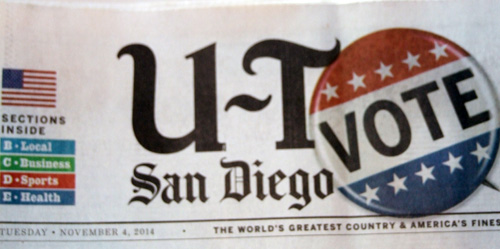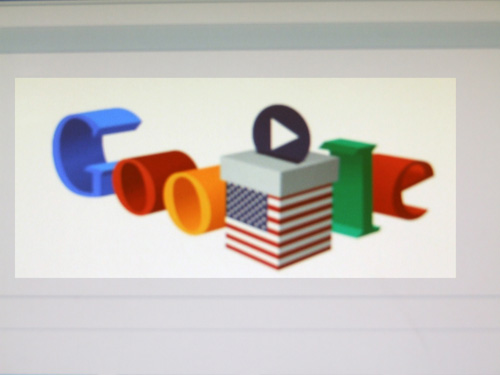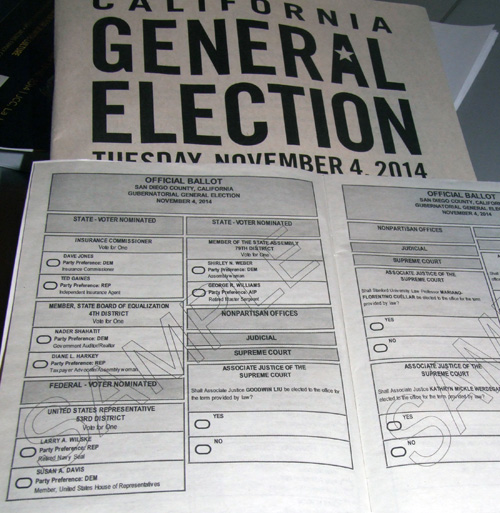
By Donald H. Harrison

SAN DIEGO — Many readers of San Diego Jewish World live outside the United States so for them, principally, I thought I would provide some insight into how an American election works. Traditionally, today, the first Tuesday after the first Monday in November, is election day, but for weeks preceding the election we receive flyers in our mailboxes, commercials on our radio and television sets, recorded messages on our telephones, advertisements in our newspapers, and yard signs in our neighborhoods extolling or criticizing the various candidates and ballot propositions. Some of this material is helpful, but some of it contributes to visual and aural pollution.
The candidates this cycle are running for a variety of offices, including California statewide positions like governor, lieutenant governor, secretary of state, controller, treasurer, attorney general, insurance commissioner and superintendent of public instruction. There are also races for the U.S. House of Representatives, state Legislature, various judicial offices, and for public college and school boards. In addition there are a number of state propositions on the ballot, having to do with such issues as bonds for water projects, financial limits on medical malpractice awards, health care plans, off-reservation Indian casinos, and mandatory prison sentences.
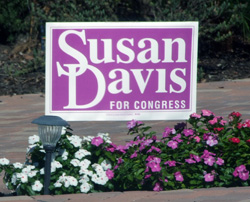
The California Secretary of State’s office sends to all voters a pamphlet in which the propositions are briefly explained and pros and cons are presented by advocates. We also receive from the County Registrar of Voters office a pamphlet showing what our ballot will look like, in case we want to mark it up and take it to the polls with us.
As editor of a Jewish news publication, I’ve been particularly interested in two local contests in which Jewish candidates were up for election. Congresswoman Susan Davis, a Democrat, ran for her eighth two-year term in this election. Deputy State Attorney General Brad Weinreb, a Republican, was in a contested race for an open Superior Court seat. Although Weinreb is a Republican, his party is not listed because judgeships are officially “non-partisan.” So too are races for municipal offices and school boards. Officially “non-partisan or not,” the Republican and Democratic political parties (as well as the smaller Third parties) are aware of the candidates’ political affiliations and try to help those of their own party. Today’s city councilman may be tomorrow’s state legislator.
The day of the election, we are reminded by our local newspaper to be sure to vote. Google also puts up an image on its search page to promote political participation.
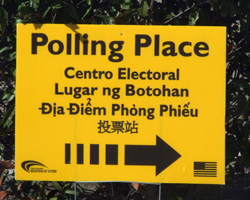 As we drive to the polls, we are aided by directional signs in five languages — English, Spanish, Tagalog (spoken in the Philippines), Vietnamese and Chinese. It is possible to obtain ballot materials in these languages as well. My polling place was at the local branch of the San Diego Public Library.
As we drive to the polls, we are aided by directional signs in five languages — English, Spanish, Tagalog (spoken in the Philippines), Vietnamese and Chinese. It is possible to obtain ballot materials in these languages as well. My polling place was at the local branch of the San Diego Public Library.
Once we arrive at the polls, we are asked our names and addresses and a poll worker flips through his/her registration book and has us sign our names next to where they are already printed.
Voters then are handed a long paper ballot, and a dark black pen, and directed to one of the nearby voting booths. A voter may take as little or as much time as he or she needs, but as I had already decided how I wanted to vote, I did not linger over my choices. I brought back the ballot, protected from a passerby’s view by a cardboard folder, and handed it to a precinct worker, who slipped it into the ballot box. It doesn’t take long at all to exercise a fundamental right in a democracy.
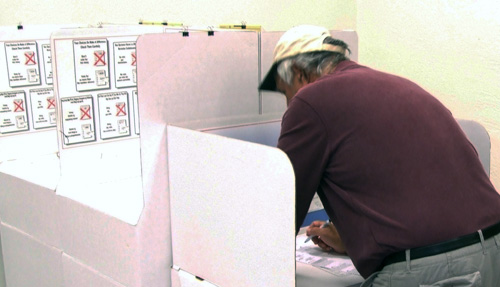
(Photo: Bob Lauritzen)
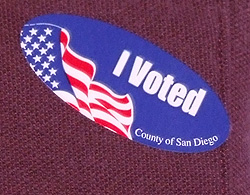 When we have completed our democratic duty of voting, we are handed a sticker to wear. The idea behind the sticker is that it will encourage other people to vote as well. I like to wear the sticker, but not everyone does. It is optional.
When we have completed our democratic duty of voting, we are handed a sticker to wear. The idea behind the sticker is that it will encourage other people to vote as well. I like to wear the sticker, but not everyone does. It is optional.
The polls are open from 7 a.m. to 8 p.m. Throughout the day, having no results to report, television news stations broadcast turnout figures–what percentage of the voters who are registered have actually made it the polls. This provides fodder for some analysts to make predictions. Generally, it is believed–though certainly not proven–that low turnouts favor Republican candidates, while high turnouts favor Democratic candidates. This hypothesis is based on the unproven belief that Republicans are more loyal voters than Democrats; they will turn out rain or shine, and during an interesting election or a boring one. Democrats, according to this popular notion, are more fickle voters. They only show up for interesting races, particularly those in good weather. I think that is a lot of hooey, but speculation like that helps fill the airwaves until some actual results come in.
At 8 p.m., the Registrar of Voters will announce the first results, tallied from absentee ballots that have been dropped off or mailed into the Registrar’s office, or filled out at the Registrar’s offices — in advance of the election. There is another political legend that because Republican voters are so much more likely to vote than Democrats that, in races for open seats, Republicans should be presumed to do better than their Democratic opponents in the absentee voter tally. If, however, the reverse is true, then immediately the news media will report that the trailing Republican candidate is in a difficult fight. This “rule” does not apply in races in which there are incumbents running, because it is generally believed that incumbents always have the advantage. If ever an incumbent trails in the absentee voting, it will be automatically assumed he or she is in real trouble.
Although people can read the returns comfortably on their home computers, many like to go to Golden Hall at the downtown Civic Center (where San Diego City Hall also is located) to watch the pageantry. News crews set up booths to announce the results and to interview candidates, whose supporters bearing placards stand behind them and cheer everything the candidate says. Sometimes these campaign crowds will march across the floor of election central, a drummer helping them to keep in step. It’s always very colorful, and really quite meaningless. No matter how loud they beat the drum, no matter how many signs they get filmed by the television cameras, it doesn’t make a difference. The polls are already closed. There are no voters left to influence. So really, it’s all for fun and to let off a little steam.
Usually, the returns are slower than the television stations would like. In a perfect world, all the counting would be done before the 11 p.m. evening news cast. But the machines that read these hand ballots aren’t that fast, and sometimes ballots are delayed getting to the readers because of traffic. Sometimes there are irregularities that officials have to look into — did a voter mark two candidates on his ballot, instead of only one? If so, both votes must be disregarded.
By the next morning, the semi-official tally has been completed, and except when the results are only a few votes apart, we know the results. However, when the votes are so close that careless errors might have made a difference, there are provisions for a recount in that race. Recounts can provide news for a few more news cycles, so it’s not a matter of great frustration for new organizations. Why make one story out of what possibly could be two good ones.
After the votes are known, analysts will tell us what it all means. If Republicans win the congressional elections, we will be told that the nation is unhappy with President Obama. If, on the other hand, the Democrats win, we will be told President Obama had a mandate. Both forms of analysis are wishful thinking. Former House Speaker Tim O’Neill (D-Massachusetts) once famously said that “all politics are local.” Those who voted for Susan Davis, for example, may say President Obama had nothing to do with it. Davis served as a member of the San Diego Board of Education and the state Assembly before she was elected in 2000 to the Congress. People around here know her, and obviously like her. People who voted for Brad Weinreb for Superior Court Judge may or may not have known that he was a Republican. They just felt he was the best qualified for the job.
*
Harrison is editor of San Diego Jewish World. He may be contacted via donald.harrison@sdjewishworld.com
